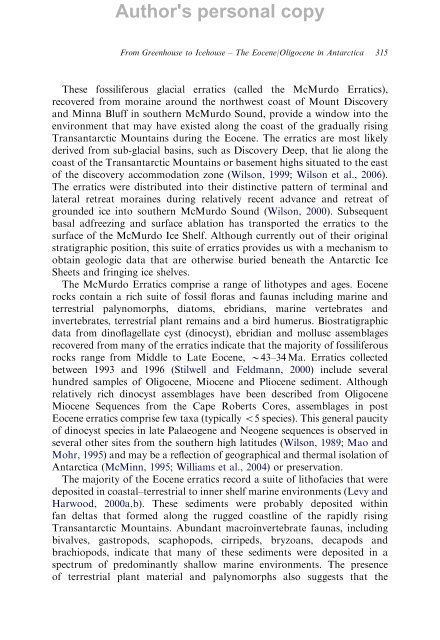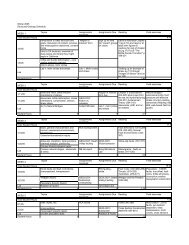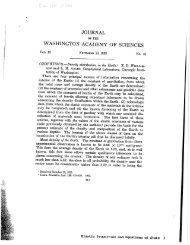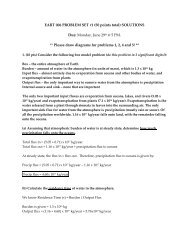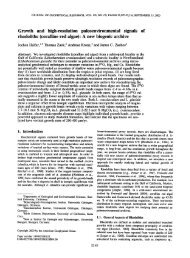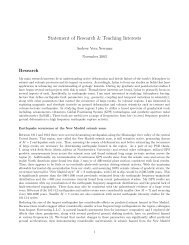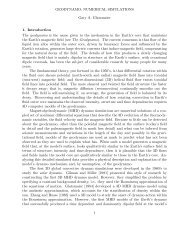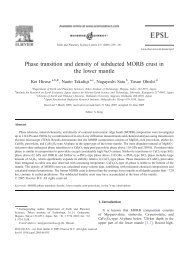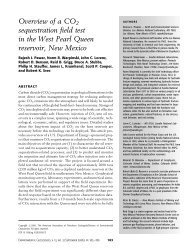From Greenhouse to Icehouse – The Eocene/Oligocene - UMass ...
From Greenhouse to Icehouse – The Eocene/Oligocene - UMass ...
From Greenhouse to Icehouse – The Eocene/Oligocene - UMass ...
Create successful ePaper yourself
Turn your PDF publications into a flip-book with our unique Google optimized e-Paper software.
Author's personal copy<br />
<strong>From</strong> <strong>Greenhouse</strong> <strong>to</strong> <strong>Icehouse</strong> <strong>–</strong> <strong>The</strong> <strong>Eocene</strong>/<strong>Oligocene</strong> in Antarctica 315<br />
<strong>The</strong>se fossiliferous glacial erratics (called the McMurdo Erratics),<br />
recovered from moraine around the northwest coast of Mount Discovery<br />
and Minna Bluff in southern McMurdo Sound, provide a window in<strong>to</strong> the<br />
environment that may have existed along the coast of the gradually rising<br />
Transantarctic Mountains during the <strong>Eocene</strong>. <strong>The</strong> erratics are most likely<br />
derived from sub-glacial basins, such as Discovery Deep, that lie along the<br />
coast of the Transantarctic Mountains or basement highs situated <strong>to</strong> the east<br />
of the discovery accommodation zone (Wilson, 1999; Wilson et al., 2006).<br />
<strong>The</strong> erratics were distributed in<strong>to</strong> their distinctive pattern of terminal and<br />
lateral retreat moraines during relatively recent advance and retreat of<br />
grounded ice in<strong>to</strong> southern McMurdo Sound (Wilson, 2000). Subsequent<br />
basal adfreezing and surface ablation has transported the erratics <strong>to</strong> the<br />
surface of the McMurdo Ice Shelf. Although currently out of their original<br />
stratigraphic position, this suite of erratics provides us with a mechanism <strong>to</strong><br />
obtain geologic data that are otherwise buried beneath the Antarctic Ice<br />
Sheets and fringing ice shelves.<br />
<strong>The</strong> McMurdo Erratics comprise a range of lithotypes and ages. <strong>Eocene</strong><br />
rocks contain a rich suite of fossil floras and faunas including marine and<br />
terrestrial palynomorphs, dia<strong>to</strong>ms, ebridians, marine vertebrates and<br />
invertebrates, terrestrial plant remains and a bird humerus. Biostratigraphic<br />
data from dinoflagellate cyst (dinocyst), ebridian and mollusc assemblages<br />
recovered from many of the erratics indicate that the majority of fossiliferous<br />
rocks range from Middle <strong>to</strong> Late <strong>Eocene</strong>, B43<strong>–</strong>34 Ma. Erratics collected<br />
between 1993 and 1996 (Stilwell and Feldmann, 2000) include several<br />
hundred samples of <strong>Oligocene</strong>, Miocene and Pliocene sediment. Although<br />
relatively rich dinocyst assemblages have been described from <strong>Oligocene</strong><br />
Miocene Sequences from the Cape Roberts Cores, assemblages in post<br />
<strong>Eocene</strong> erratics comprise few taxa (typically o5 species). This general paucity<br />
of dinocyst species in late Palaeogene and Neogene sequences is observed in<br />
several other sites from the southern high latitudes (Wilson, 1989; Mao and<br />
Mohr, 1995) and may be a reflection of geographical and thermal isolation of<br />
Antarctica (McMinn, 1995; Williams et al., 2004) or preservation.<br />
<strong>The</strong> majority of the <strong>Eocene</strong> erratics record a suite of lithofacies that were<br />
deposited in coastal<strong>–</strong>terrestrial <strong>to</strong> inner shelf marine environments (Levy and<br />
Harwood, 2000a,b). <strong>The</strong>se sediments were probably deposited within<br />
fan deltas that formed along the rugged coastline of the rapidly rising<br />
Transantarctic Mountains. Abundant macroinvertebrate faunas, including<br />
bivalves, gastropods, scaphopods, cirripeds, bryzoans, decapods and<br />
brachiopods, indicate that many of these sediments were deposited in a<br />
spectrum of predominantly shallow marine environments. <strong>The</strong> presence<br />
of terrestrial plant material and palynomorphs also suggests that the


